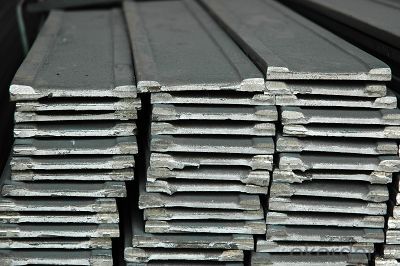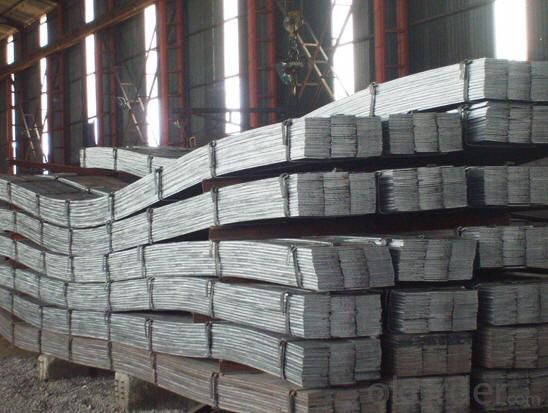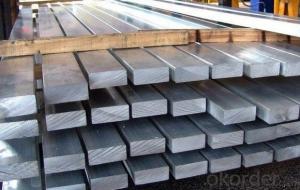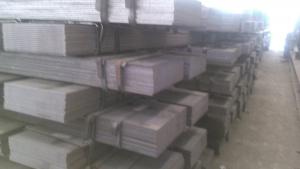Stainless steel flat bar in Grade Q235 for construction
- Loading Port:
- Tianjin
- Payment Terms:
- TT OR LC
- Min Order Qty:
- 10000 m.t.
- Supply Capability:
- 100000 m.t./month
OKorder Service Pledge
OKorder Financial Service
You Might Also Like
Product Description:
OKorder is offering stainless steel flat bar in Grade Q235 for construction at great prices with worldwide shipping. Our supplier is a world-class manufacturer of steel, with our products utilized the world over. OKorder annually supplies products to European, North American and Asian markets. We provide quotations within 24 hours of receiving an inquiry and guarantee competitive prices.
Product Applications:
Stainless steel flat bar are ideal for structural applications and are widely used in the construction of buildings and bridges, and the manufacturing, petrochemical, and transportation industries.
Product Advantages:
OKorder's Steel Flat Bar for construction are durable, strong, and resist corrosion.
Main Product Features:
· Premium quality
· Prompt delivery & seaworthy packing (30 days after receiving deposit)
· Corrosion resistance
· Can be recycled and reused
· Mill test certification
· Professional Service
· Competitive pricing
Product Specifications:
carbon flat steel bar
1.Thickness:1.5mm-14mm
2.Width:10mm-1010mm
3.Grade:Q235, Q345, A36
4. BV verified
Details of carbon flat steel bar
Advantage carbon flat steel bar
1. Convenient in construction and save much time and labor
2. High mechanical strength
3. Low price, high quality
carbon flat steel bar specifications
FAQ
Q1: How do we guarantee the quality of our products?
A1: We have established an advanced quality management system which conducts strict quality tests at every step, from raw materials to the final product. At the same time, we provide extensive follow-up service assurances as required.
Q2: What makes stainless steel stainless?
A2: Stainless steel must contain at least 10.5 % chromium. It is this element that reacts with the oxygen in the air to form a complex chrome-oxide surface layer that is invisible but strong enough to prevent further oxygen from "staining" (rusting) the surface. Higher levels of chromium and the addition of other alloying elements such as nickel and molybdenum enhance this surface layer and improve the corrosion resistance of the stainless material.



- Q:Can steel flat bars be used for making conveyor systems?
- Yes, steel flat bars can be used for making conveyor systems. Steel flat bars are known for their strength, durability, and resistance to corrosion, making them an ideal choice for conveyor systems that need to handle heavy loads and withstand constant use. The flat shape of the bars allows for easy attachment of rollers or other components, making it easier to assemble and customize the conveyor system. Additionally, steel flat bars can be easily welded or bolted together, providing flexibility in designing and constructing conveyor systems of various sizes and configurations.
- Q:How do steel flat bars compare to wood for certain applications?
- Certain applications benefit from the use of steel flat bars instead of wood for several reasons. Firstly, steel is significantly stronger and more durable than wood, making it ideal for heavy-duty applications where strength is of utmost importance. Steel flat bars can withstand higher loads and pressures compared to wooden bars, making them suitable for providing structural support in construction projects. Moreover, steel flat bars do not succumb to issues such as rot, decay, or pest infestations, which are prevalent in wood. This renders steel a more reliable and long-lasting material, especially in outdoor or moist environments. Additionally, steel is fire-resistant, unlike wood, which can be a critical consideration in applications where fire safety is a concern. Another advantage of steel flat bars lies in their consistent and uniform dimensions. Unlike wood, which can vary in size and shape due to natural defects, steel flat bars are precisely manufactured and maintain consistent dimensions throughout. This facilitates ease of use and ensures accurate and precise fittings in construction or fabrication applications. Furthermore, steel flat bars are easily recyclable, contributing to a more sustainable choice compared to wood. Steel is highly recyclable, and opting for steel flat bars over wood aids in reducing deforestation and minimizing environmental impact. Nevertheless, it is important to acknowledge that wood also possesses advantages in certain applications. Wood is a natural material that imparts a warm and visually appealing appearance, which may be desirable in architectural or interior design projects. Additionally, wood can be more manageable and offer greater flexibility in terms of shaping or customization. In conclusion, steel flat bars surpass wood in terms of strength, durability, resistance to rot and pests, fire safety, and dimensional consistency. However, the selection between steel and wood ultimately hinges on the specific requirements and aesthetics of the given application.
- Q:Can steel flat bars be used for making brackets or supports for medical equipment?
- Steel flat bars are indeed suitable for creating brackets or supports for medical equipment. The reason is that steel is a robust and long-lasting material capable of offering the required stability and support necessary for medical equipment. Moreover, it possesses exceptional load-bearing capabilities and can endure substantial pressure or weight. Additionally, steel exhibits resistance to corrosion, a vital trait for medical equipment that may encounter moisture or other potentially harmful substances. In summary, due to their strength, durability, and corrosion resistance, steel flat bars are an appropriate option for fabricating brackets or supports for medical equipment.
- Q:How do steel flat bars perform in terms of UV resistance?
- Steel flat bars lack inherent UV resistance properties, making them susceptible to negative effects when exposed to ultraviolet (UV) radiation from sunlight. Extended exposure to UV rays can cause degradation and brittleness in steel over time, resulting in discoloration, oxidation, and structural weaknesses in flat bars. To address these issues and enhance UV resistance, various methods can be utilized. One commonly employed approach involves applying protective coatings, such as paint or specialized finishes, to the steel surface. These coatings act as a barrier, shielding the steel from direct UV exposure and preventing degradation. Moreover, stainless steel flat bars tend to exhibit superior resistance to UV radiation compared to carbon steel. This is due to the presence of chromium in stainless steel, which forms a passive oxide layer offering some natural UV protection. However, it is important to note that even stainless steel can still be affected by intense UV rays when exposed for prolonged periods. Ultimately, when considering the use of steel flat bars in outdoor or UV-exposed applications, it is essential to carefully consider the specific environment, level of UV exposure, and the necessity for additional protective measures. These considerations are crucial for ensuring the longevity and performance of the steel flat bars.
- Q:What are the different grades of steel used for flat bars?
- There are several grades of steel used for flat bars, including low carbon steel (1018, A36), medium carbon steel (1045), high carbon steel (1095), alloy steel (4140), and stainless steel (304, 316). The choice of grade depends on the specific application and desired properties such as strength, durability, and corrosion resistance.
- Q:How strong are steel flat bars?
- Strength and durability are characteristics commonly associated with steel flat bars. The grade and composition of the steel used can affect the strength of these flat bars. Mild steel, which contains a low amount of carbon, is often used to create steel flat bars due to its ductility and ease of manipulation. Mild steel flat bars possess moderate strength and find application in various fields, including construction, manufacturing, and fabrication. Conversely, high-strength steel flat bars, crafted from alloys or subjected to heat treatment, exhibit significantly enhanced strength properties. These specialized flat bars are designed to endure substantial loads, resist deformation, and offer structural support in demanding scenarios. Their usage is prevalent in industries such as construction, automotive, and aerospace. In general, steel flat bars are acknowledged for their strength and capacity to withstand substantial force and weight. Nonetheless, selecting the appropriate grade and size of steel flat bar for a particular application is crucial to ensure optimal strength and performance. Consulting with a structural engineer or steel supplier can aid in determining the most suitable type of steel flat bar for a specific project.
- Q:How do I determine the strength of a steel flat bar?
- To determine the strength of a steel flat bar, you need to consider its grade, which indicates the alloy composition and mechanical properties of the steel. The grade is usually marked on the bar or can be obtained from the manufacturer's specifications. Additionally, you can refer to industry standards or consult engineering handbooks that provide information on the strength and properties of various steel grades.
- Q:Can steel flat bars be coated with anti-slip materials?
- Yes, steel flat bars can be coated with anti-slip materials. There are various methods and materials available for coating steel flat bars to provide an anti-slip surface. One commonly used material is a non-slip epoxy coating that contains aggregates such as aluminum oxide or silicon carbide. These aggregates create a rough surface that enhances grip and prevents slips or falls. Additionally, other materials like rubber, vinyl, or adhesive tapes with anti-slip properties can also be applied to steel flat bars to increase their slip resistance. These coatings can be beneficial in areas where slip hazards are present, such as walkways, ramps, stairs, or industrial settings. Properly coating steel flat bars with anti-slip materials improves safety and reduces the risk of accidents in various environments.
- Q:Are steel flat bars suitable for architectural applications?
- Yes, steel flat bars are suitable for architectural applications. They offer excellent strength, durability, and versatility, making them ideal for various architectural designs. Additionally, steel flat bars can be easily customized and fabricated to meet specific architectural requirements, making them a popular choice among architects and designers.
- Q:Are steel flat bars suitable for electrical grounding?
- Yes, steel flat bars can be suitable for electrical grounding. Steel is a good conductor of electricity, which is an essential property for grounding materials. When properly installed and connected to the electrical system, steel flat bars can effectively dissipate electrical charges and provide a safe pathway for electrical faults to be directed to the ground. However, it is important to ensure that the steel bars are securely bonded and connected to the grounding system according to the applicable electrical codes and standards. Additionally, regular maintenance and inspections should be carried out to ensure the integrity and effectiveness of the grounding system.
1. Manufacturer Overview |
|
|---|---|
| Location | |
| Year Established | |
| Annual Output Value | |
| Main Markets | |
| Company Certifications | |
2. Manufacturer Certificates |
|
|---|---|
| a) Certification Name | |
| Range | |
| Reference | |
| Validity Period | |
3. Manufacturer Capability |
|
|---|---|
| a)Trade Capacity | |
| Nearest Port | |
| Export Percentage | |
| No.of Employees in Trade Department | |
| Language Spoken: | |
| b)Factory Information | |
| Factory Size: | |
| No. of Production Lines | |
| Contract Manufacturing | |
| Product Price Range | |
Send your message to us
Stainless steel flat bar in Grade Q235 for construction
- Loading Port:
- Tianjin
- Payment Terms:
- TT OR LC
- Min Order Qty:
- 10000 m.t.
- Supply Capability:
- 100000 m.t./month
OKorder Service Pledge
OKorder Financial Service
Similar products
New products
Hot products
Related keywords





























